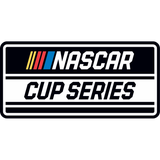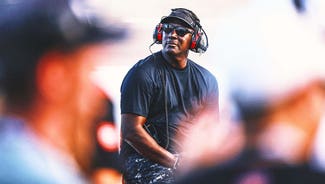
20 Years of Yellow-Line Controversy
By Bob Pockrass
Whether necessary or not, it’s hard to like NASCAR’s yellow-line rule for races at Daytona and Talladega, which again forced NASCAR officials to make critical decisions on the final lap Sunday afternoon in the playoff race at Talladega.
Here’s the rule, straight from the rule book:
"Vehicles must race above the double yellow lines around the entire race track. If in NASCAR's judgement, the vehicle(s) goes beneath the double yellow lines to improve its position, vehicle(s) will be black-flagged. If in NASCAR's judgement a vehicle forces another vehicle beneath the double yellow lines (in an effort to stop the advancement/pass) the vehicle may be black-flagged.
"NASCAR defines beneath the double yellow lines as follows: when the vehicle's left side tires are beneath the left line of the inside double yellow lines that separates the apron from the racing surface while passing another vehicle."
It’s hard not to notice that twice in the rule, it states, "if in NASCAR’s judgement." Therein lies the issue, because what someone views as being forced below the line is debatable — and potentially objective depending on who is heading up officiating for the series. Also not mentioned is that NASCAR wouldn’t enforce the rule if a driver is avoiding an accident.
So when NASCAR penalized Joey Logano twice at Talladega for forcing drivers below the yellow line, that was a little surprising.
And then on the final lap, NASCAR penalized Matt DiBenedetto for forcing William Byron and others below the yellow line as they attempted to avoid an accident, and Chase Elliott for passing below the yellow line.
But then when Elliott’s team filed an official protest, NASCAR overturned Elliott’s penalty and penalized Chris Buescher for forcing him below the yellow line.
Amidst it all, Denny Hamlin, the winner, was not penalized, as NASCAR determined he was trying to avoid a potential wreck that could have been started by DiBenedetto
"The 21 [of DiBenedetto] hung a left, drove those guys down below the line," NASCAR Senior Vice President of Competition Scott Miller said. "We called that twice on the 22 car [of Logano] during the race, so nothing different there.
"On the 24 [of Byron] and the 11 [of Hamlin] being down there, I mean, in our judgment they were down there to avoid a wreck ... I think all of it was, from our vantage point, I think fairly clear‑cut."
Except it obviously all wasn’t, since Miller, speaking prior to the protest, had also indicated that Elliott’s penalty was clear-cut.
The rule has been in place since 2001 as a way to avoid accidents by drivers trying to come from the apron of the track back into the racing line in the draft. Many drivers are in favor of the rule, which has resulted in controversial rulings for about as long as it has been in existence.
"You'd probably see more wrecks without it, guys being able to dive down there, trying to make big moves," said Erik Jones after this second-place finish. "You'd probably see more accidents than what we have now.
"I don't honestly know what to do to make it better. I know it's unfortunate when it comes down to the end of the race."
NASCAR changed the aero rules and horsepower for races at Daytona and Talladega earlier this year following the scary Ryan Newman crash in the Daytona 500. That potentially has made drivers attempt to make moves to block, thinking they can stall the runs easier since they have less horsepower. The cars also seem to handle better, giving drivers potentially a little more confidence.
Hamlin scoffed that NASCAR’s calls should be the focus of the postrace news conference. He said they had been calling it all race and he felt he clearly went down below the yellow line to avoid an accident.
"I've been a victim of getting forced down there all the time," Hamlin said. "Finally they put their foot down and said, 'This is the rule, we're going to enforce it.'
"You can't as a leader, wherever you are, use the yellow line as a defense. You have to play within the boundaries that they set ...They set the precedent early so you know you weren't going to get away with it."
But Hamlin also understood the moves being made.
"It's part of it," he said. "I wouldn't say I would have done anything different if I was Matt. I don't know. I'm not a huge blocking guy. I don't always think you have to block to win."
There is no other way to stop a run unless a driver blocks. You might not have to block to win, but you have to block not to lose.
As Hamlin noted, NASCAR was consistent with the calls throughout the race. Maybe, just maybe, should NASCAR not have the rule for the final lap or overtime?
Miller bristled at that suggestion, saying there would be more wrecks.
"I do sincerely believe we need the rule," he said. "You see all the real estate that's around here.
"If we started having cars running 12-wide down the back straightaway, imagine what would happen when you get to Turn 3?"
There would probably be a big wreck. The argument would be that there are big wrecks anyway, so what is NASCAR really avoiding?
With 20 years of having this rule, no one really knows. And trying to find out would be another roll-of-the-dice at tracks where there already is enough of that element.
So maybe leaving Talladega with a finish that is hard to stomach for many fans has to be the answer, an imperfect answer for a drafting racing style that some will always love and some will always hate.
Xfinity: Haley advances; Annett DQ
Justin Haley earned his third consecutive win at a drafting track (Talladega-Daytona-Talladega) and he won Saturday by being in the lead on a late-race crash. That vaulted him into the playoffs semifinal round.
But this race upended the playoffs.
The driver who finished second, Michael Annett, was disqualified for being 1/16ths of an inch too low on the left front in postrace measurements. Instead of being three points behind the cutoff, he is now 38 points behind, a devastating blow to his playoff hopes.
Meanwhile, Ryan Sieg, who probably wasn’t in many playoff brackets to advance, is 27 points ahead of the cutoff.
Trucks: Lessard first victory
Raphael Lessard earned his first win, and the Kyle Busch Motorsports rookie has had a tough year. Not only did he miss qualifying for the playoffs, the Canadian also has missed having his family around, as they have not been able to travel across the border.
"My family is all in Quebec," Lessard said. "It’s been crazy and I haven’t seen them in a while ... I needed that. We had a tough season so this one feels really good."
On The Air
Saturday
Xfinity Driver For The Cure 250 (Charlotte road course), 3:30 p.m. ET, NBC
Sunday
Cup Bank of America 400 (Charlotte road course), 2:30 p.m. ET, NBC
Stat of Note
Denny Hamlin (winner) and Chase Elliott (fifth) were the only playoff drivers in the top-10.
Social Spotlight
They Said It
"Called it all day. It's a non‑story." – Denny Hamlin on the yellow-line rule

